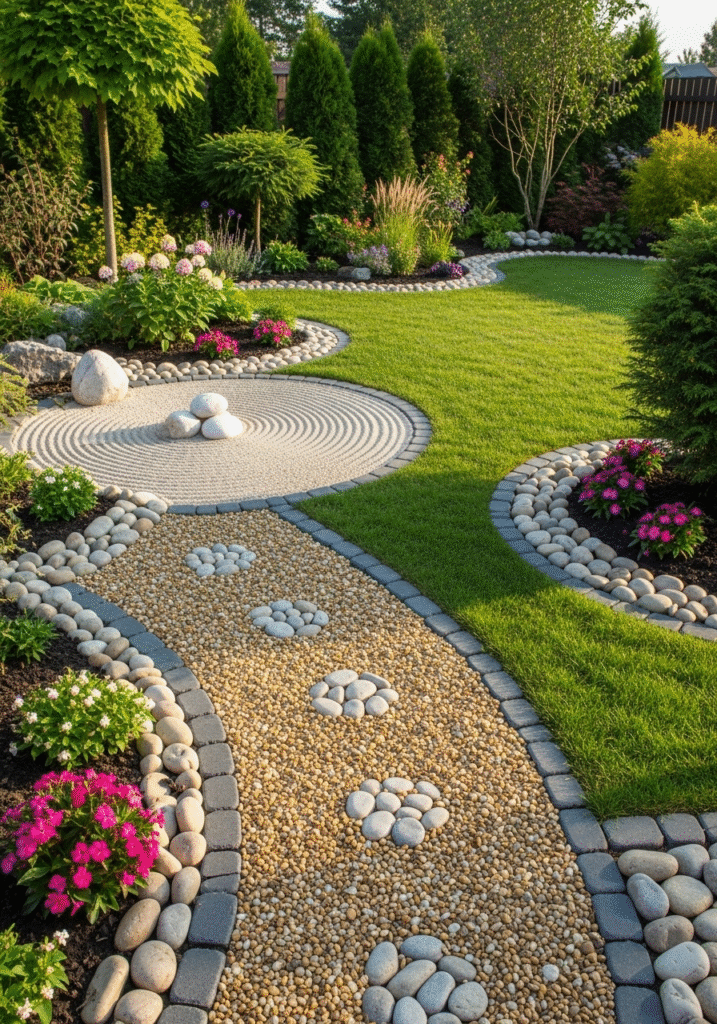Introduction
Gardening is not just about planting flowers and vegetables — it’s also about creating a visually appealing and peaceful environment. One of the most affordable, natural, and creative ways to enhance your garden’s aesthetic is by using pebbles. These small stones come in different sizes, shapes, and colors, offering endless possibilities for decorative landscaping. Whether you’re aiming for a modern minimalist look or a cozy natural retreat, decorating your garden with pebbles can elevate its charm instantly.
In this blog post, we’ll explore the many ways you can use pebbles to decorate your garden, from pathways to planters. You’ll also find practical tips on choosing the right type of pebble, how to lay them properly, and how to maintain them over time. Let’s dive into the world of garden decoration with pebbles!
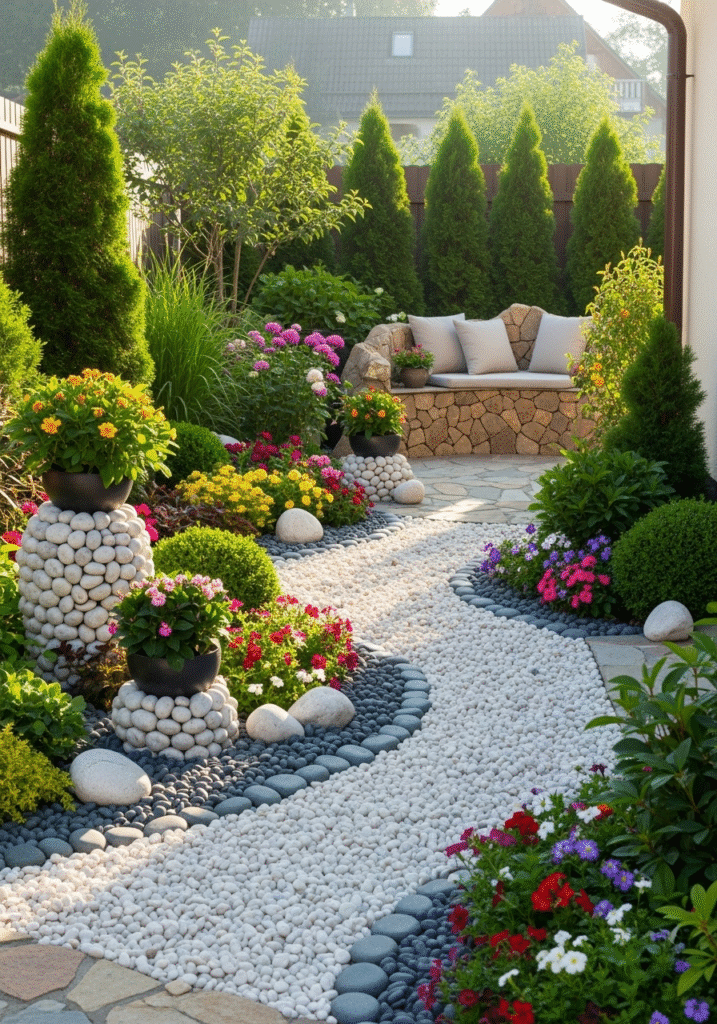
Why Use Pebbles for Garden Decoration?
Pebbles are far more than just visually pleasing stones — they are one of the most versatile, durable, and practical materials you can use in your garden. Whether you’re a passionate gardener or someone who simply wants to upgrade the aesthetic of an outdoor space, pebbles offer a perfect blend of beauty and functionality. Let’s explore the many reasons why homeowners, landscapers, and garden enthusiasts across the world are choosing pebbles as a core element of their garden decoration strategy.
1. Natural and Eco-Friendly
One of the most attractive qualities of pebbles is that they are a 100% natural product. Formed over time by natural processes like river flows and erosion, pebbles do not emit any harmful chemicals or pollutants into the environment. This makes them an excellent choice for environmentally conscious gardeners. Unlike synthetic materials or chemically treated landscaping solutions, pebbles maintain the natural balance of your garden ecosystem.
They’re also reusable — if you decide to change your garden layout, you can simply collect and repurpose the pebbles elsewhere. This reduces waste and supports sustainable gardening practices.
2. Low Maintenance Solution
One of the biggest advantages of using pebbles is that they require very little upkeep compared to other landscaping materials like grass, wood mulch, or decorative tiles.
Grass needs to be watered, mowed, and fertilized regularly. Mulch decomposes over time and needs to be replaced every season. Tiles can break or collect moss and algae. Pebbles, on the other hand, can last for years without needing to be replaced or maintained. A simple rinse with a hose from time to time is often enough to keep them looking clean and fresh.
If you’re looking for a long-lasting decorative option that won’t demand your constant attention, pebbles are a perfect choice.
3. Natural Weed Control
Dealing with unwanted weeds is a constant battle for many gardeners. Pebbles offer a simple yet effective solution for suppressing weed growth. When used as a ground cover over landscape fabric, pebbles create a barrier that makes it difficult for weeds to grow through.
Unlike mulch, which can decompose and create a nutrient-rich environment for weeds, pebbles form a solid, non-organic layer that inhibits light and air from reaching the soil. This discourages weed germination and growth, helping you maintain a cleaner and more orderly garden with minimal effort.
4. Improved Drainage and Erosion Control
Another practical benefit of using pebbles in the garden is their ability to enhance water drainage. Poor drainage can lead to standing water, root rot, and soil erosion — all of which can damage your plants and compromise your garden’s structure.
Pebbles help by allowing water to pass through easily, preventing the pooling of water and promoting better soil aeration. This makes them particularly useful around plant beds, walkways, and garden borders. They also help stabilize the soil on slopes or uneven ground, reducing erosion over time.
5. Stunning Aesthetic Appeal
Beyond their functional benefits, pebbles also bring unmatched aesthetic value to your garden. Available in a wide range of colors, textures, and sizes, pebbles can complement virtually any garden theme — whether it’s rustic, tropical, minimalist, or Zen-inspired.
You can use light-colored pebbles to brighten shaded areas or opt for dark tones to add contrast around vibrant flower beds. Mix and match different shapes and hues to create visually engaging patterns or pathways. Their smooth, polished finish or natural ruggedness adds character and elegance to the landscape, transforming ordinary garden spaces into works of art.
Final Thoughts
Whether you’re looking to reduce garden maintenance, improve drainage, prevent weed growth, or simply beautify your outdoor space, pebbles are an excellent choice. Their eco-friendly nature, long-lasting durability, and decorative versatility make them one of the most practical and stylish garden materials available today.
If you want your garden to be both functional and beautiful with minimal effort, investing in pebble decoration is a smart and sustainable decision.
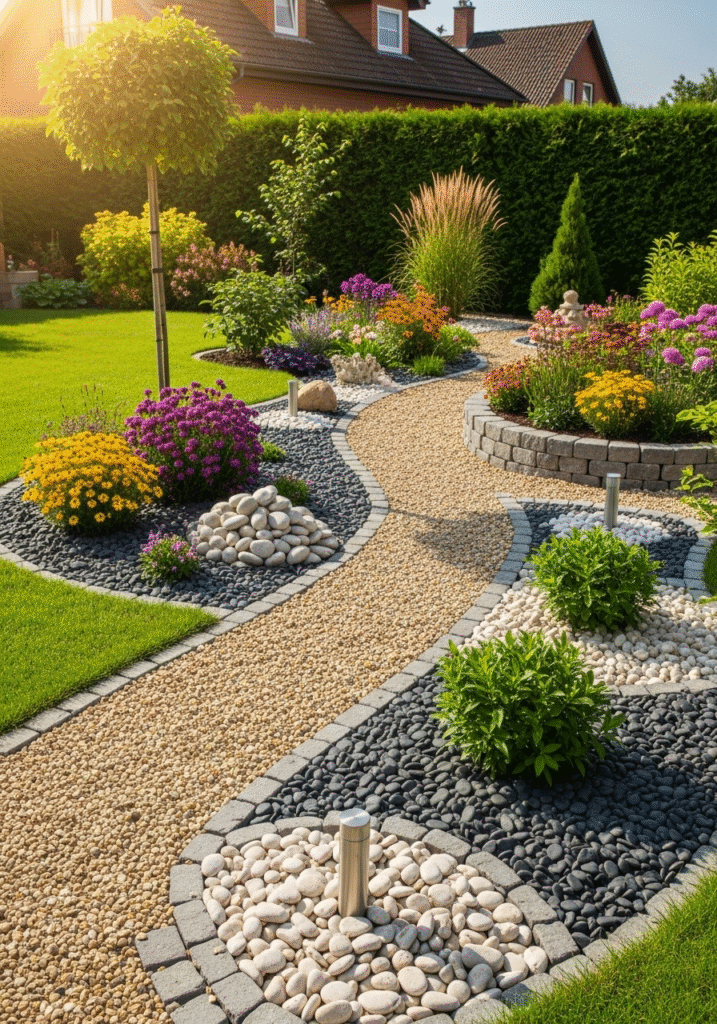
Types of Pebbles for Garden Use
Choosing the right type of pebble can dramatically impact the look, feel, and functionality of your garden. With so many shapes, colors, textures, and finishes available, it’s important to understand what each type offers and how best to use it in your landscape design. Whether you’re going for a clean, minimalist look or a more natural, rustic style, there’s a pebble type that’s perfect for your needs. Below are the most popular types of pebbles used in garden decoration — each with its unique properties and visual appeal.
1. River Pebbles
Best for: Pathways, water features, borders, and planters
River pebbles are among the most commonly used stones in garden design. These pebbles are naturally smooth and rounded due to years of tumbling in riverbeds. They come in a wide range of earthy colors like browns, grays, whites, and greens, giving them a natural and organic appearance.
Because of their soft, rounded edges, river pebbles are comfortable to walk on, making them an excellent choice for pathways and foot traffic areas. They also work well in and around water features like ponds, fountains, or dry creek beds, where they enhance the natural vibe. Additionally, river pebbles can be used as a decorative layer on top of potted plants to improve drainage and suppress weeds.
2. Polished Pebbles
Best for: Accent decor, mosaic designs, indoor/outdoor pots, garden art
Polished pebbles are river stones or other natural pebbles that have been mechanically polished to give them a smooth, glossy finish. They are often available in vibrant colors like red, black, white, blue, green, or multicolor mixes, adding a modern and artistic touch to your garden.
These stones are ideal for decorative accents rather than large coverage. You can use them in mosaic art projects, garden murals, tabletop gardens, terrariums, or as highlights within a larger pebble arrangement. Their shiny finish makes them a favorite for contemporary or artistic landscapes and indoor garden designs.
3. Crushed Pebbles
Best for: Driveways, high-traffic paths, edging, and ground cover
Crushed pebbles differ significantly from river stones. These are angular and jagged rather than smooth and round. Because of their sharp edges, crushed pebbles interlock better than rounded stones, providing more grip and stability on sloped surfaces or high-traffic pathways.
They are perfect for areas where function and traction are a priority — like garden stairs, driveways, or walkways that receive regular use. Their texture also makes them an excellent choice for defining edges or creating visual contrast when used alongside smoother pebble types. Crushed pebbles typically come in natural gray, white, or black tones.
4. White Marble Pebbles
Best for: Minimalist gardens, formal layouts, plant beds, and borders
White marble pebbles are highly decorative and exude elegance and purity. These smooth, bright white stones are often used to create a clean, sophisticated look in modern garden settings. They reflect light beautifully, making them ideal for brightening up dark corners or shaded areas in your garden.
Marble pebbles are particularly effective when used in symmetrical layouts or geometric patterns. You can pair them with dark-colored plants or black lava rocks for striking contrast. Additionally, white marble stones are commonly used in rooftop gardens, terrace setups, or as a luxurious top layer for plant beds and pots.
5. Black Lava Pebbles
Best for: Zen gardens, dry landscapes, contrast layering, fire pit zones
Black lava pebbles are unique volcanic stones with a porous, matte texture and dark charcoal to jet-black color. These lightweight and heat-resistant pebbles are perfect for creating bold contrasts in garden beds or highlighting specific areas.
Because of their calming and minimalist aesthetic, black lava stones are a popular choice in Zen-style gardens or dry landscapes. You can also use them around fire pits, in Japanese rock gardens, or as a dramatic background for vibrant plants and decorative sculptures. Their porous nature also promotes good airflow and water retention around the base of plants.
Final Thoughts
Each type of garden pebble offers its own set of characteristics that can enhance different parts of your landscape. Whether you want the smooth, natural look of river pebbles, the luxurious finish of white marble stones, or the bold impact of black lava pebbles, choosing the right one depends on your garden’s style, purpose, and personality.
Mixing different types of pebbles can also create layered textures and vibrant contrasts, adding more depth and artistry to your outdoor space. Take the time to consider your garden’s layout and what message you want to convey — because with the right type of pebble, your garden can truly become a work of art.
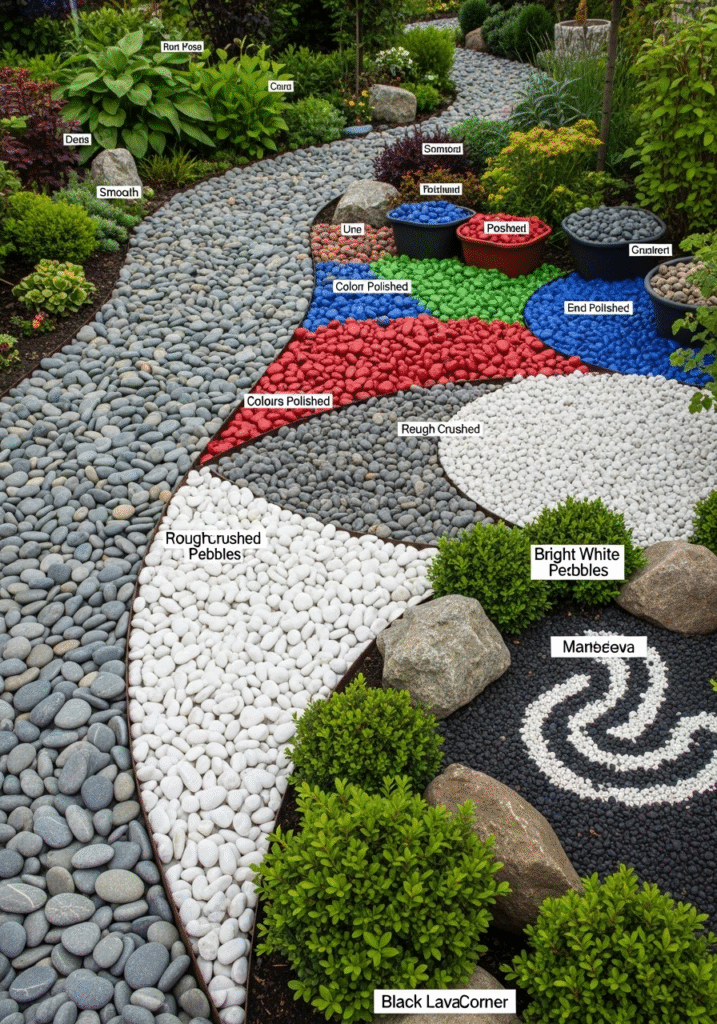
Best Areas in Your Garden to Decorate with Pebbles
One of the most attractive qualities of pebbles is their incredible versatility. These decorative stones can be used in almost every corner of your garden to elevate the aesthetic and add functional benefits such as weed suppression, drainage improvement, and ground stabilization. Whether your garden is large or small, pebbles can bring structure, texture, and visual harmony when placed in the right spots.
Below are some of the best and most impactful areas in your garden where you can use pebbles to enhance both design and practicality.
1. Garden Pathways
One of the most common and effective uses of pebbles is to create or enhance garden pathways. Pebble walkways add a natural, inviting touch and guide visitors through your garden in a visually pleasing manner.
Smooth river pebbles can be laid loosely or embedded between stepping stones for a softer, more comfortable feel underfoot. For added grip and structure, crushed or angular pebbles can be used to prevent slipping and movement. Consider outlining your pebble paths with bricks, wood, or larger stones to create definition and prevent spillage.
Pebble paths are also an excellent way to break up green areas and reduce lawn maintenance.
2. Around Flower Beds
Flower beds can instantly appear more vibrant and structured when framed with pebbles. Placing pebbles around flower beds not only helps in defining the edges but also creates a clean, polished look that makes your plants stand out.
Using light-colored pebbles such as white marble or beige tones can contrast beautifully with dark soil and colorful blooms, making the garden appear brighter and more spacious. You can also use multi-colored or naturally weathered pebbles to blend in with a rustic or cottage-style theme.
In addition to aesthetics, pebbles around flower beds help suppress weeds and retain soil moisture, offering a practical solution alongside their decorative value.
3. Beneath Trees
The base of large trees is often overlooked, becoming a space for weeds, exposed roots, or patchy soil. Adding pebbles around tree trunks can create a clean, circular or square area that enhances the structure of your garden.
This decorative touch adds depth to the landscape and can be used to unify other garden elements. Pebbles also reduce soil erosion and prevent mud from splashing onto tree trunks during rainfall. For added elegance, consider mixing pebbles with shade-tolerant ground cover plants or accent lighting.
Just be sure to leave a small gap between the pebbles and the tree base to allow proper airflow to the roots.
4. Patio or Porch Edges
Pebbles are an excellent way to frame or soften the edges of patios, porches, and outdoor seating areas. They can act as a transitional element between hard surfaces like tiles or concrete and the surrounding greenery.
Using a contrasting color of pebbles helps define the seating area and adds a subtle, stylish detail that completes the look of your patio. You can also incorporate pebbles into decorative patterns or borders, enhancing the overall harmony between your hardscape and softscape features.
In evening settings, combine pebble edges with low-level lighting for a beautiful nighttime effect.
5. Planters and Pots
Placing pebbles on top of the soil in your potted plants and garden containers is a small but impactful way to elevate their appearance. Not only do the pebbles create a clean, modern finish, but they also help retain soil moisture and reduce splash-back when watering.
This technique works well for both indoor and outdoor plants and can be matched with your garden’s color palette for a cohesive look. White or black polished pebbles are particularly popular for planters in minimalist or contemporary garden designs.
Additionally, pebbles can prevent pets or birds from disturbing the soil in your pots.
6. Water Features
If your garden includes fountains, ponds, birdbaths, or other water features, pebbles can add a stunning natural touch. Smooth river rocks or black lava pebbles look especially beautiful when wet, enhancing the serene, flowing feel of the water.
Use pebbles to line the edges of ponds or place them at the bottom of shallow water containers to mimic the look of natural creek beds. They also help improve water clarity by keeping mud and debris from stirring. For dry riverbeds or artificial streams, pebbles are essential to achieving a realistic effect.
You can even incorporate underwater lighting for added visual appeal at night.
Final Thoughts
Strategically placing pebbles throughout your garden can significantly elevate its style and function. From guiding walkways to highlighting trees, from framing patios to enhancing water features — pebbles provide both practicality and beauty. Their natural elegance, low maintenance, and wide variety of textures and colors make them a smart investment for any garden enthusiast.
Whether you’re designing from scratch or upgrading existing spaces, start with these key areas to get the most impact from your pebble decorations.
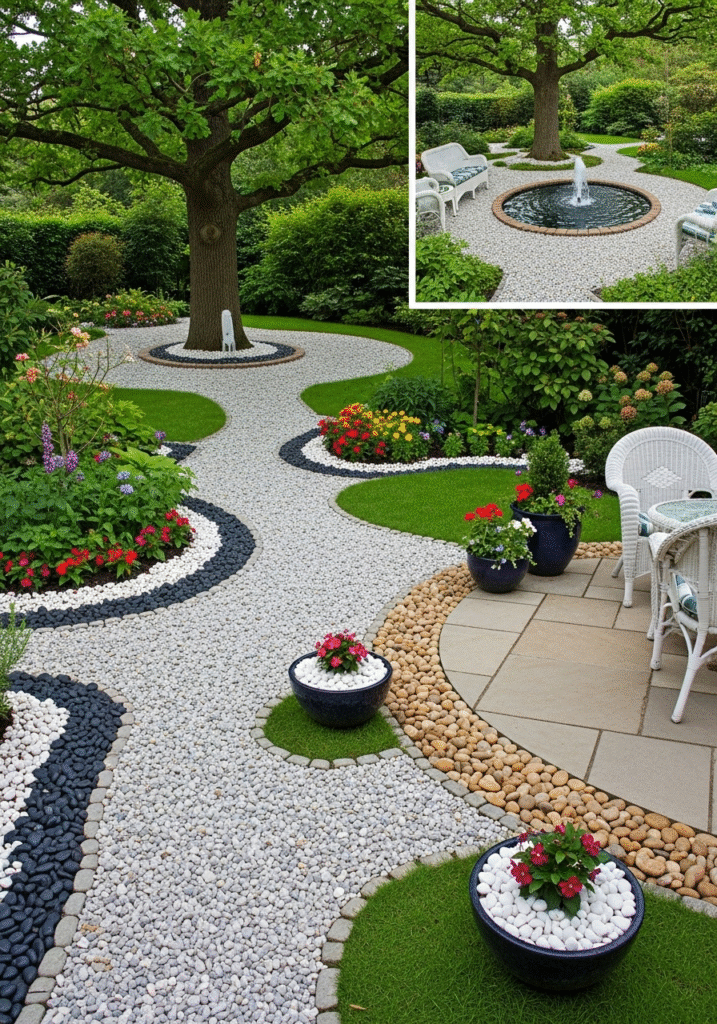
Creative Garden Decoration Ideas with Pebbles
When it comes to garden design, pebbles offer unlimited creative potential. These small yet impactful stones can be used in various imaginative ways to transform ordinary spaces into stunning landscapes. Their natural textures, colors, and versatility make them the ideal material for artistic and functional garden decoration.
From pathways and planters to Zen corners and mosaic art, here are some of the most inspiring and practical ideas to use pebbles in your garden décor:
1. Pebble Pathways
Add structure, function, and beauty to your garden.
Creating a pathway with pebbles is one of the most classic and functional design ideas. Whether you opt for a narrow winding trail or a straight, structured walkway, pebble paths help guide foot traffic while adding charm to the landscape.
Use crushed stone or medium-sized pebbles to form the base of your path. Add stepping stones or large flat rocks at intervals to create visual rhythm and provide solid footing. For a more artistic touch, consider using colored pebbles to create swirling patterns or border outlines along the path edges.
Pebble pathways are not only visually appealing but also help with water drainage and reduce muddy areas during rain.
2. Pebble Mosaic Art
Turn your garden into an outdoor canvas.
One of the most creative ways to use pebbles in your garden is to form mosaic art designs. Using multi-colored and variously shaped pebbles, you can create stunning patterns and images directly on the ground or embedded into a patio or courtyard floor.
Common designs include spirals, mandalas, floral patterns, waves, or even abstract art. Mosaic art adds a unique, personalized element to your garden and becomes a talking point for visitors. It’s ideal for artistic gardeners who want to express creativity through landscaping.
This technique works best when pebbles are set into a base of mortar, concrete, or a compacted sand bed.
3. Pebble Borders for Flower Beds
Define edges and highlight natural beauty.
Using pebbles to border flower beds instantly adds a polished and organized look to your garden layout. Clean, well-defined edges prevent the overgrowth of grass and weeds into flower beds and help frame your colorful plants in a stylish way.
Choose contrasting pebbles — such as white, black, or gray — to make the flower colors pop. For example, white marble pebbles around green shrubs or bright annuals can create an elegant contrast. These borders not only enhance visual structure but also reduce soil erosion and keep mulch in place during heavy rain.
4. Pebble-Filled Planters
Upgrade your pots with texture and elegance.
Pebbles can be used on the surface of soil in potted plants and planters to add a tidy, finished look. This technique serves both decorative and functional purposes.
A layer of pebbles helps retain soil moisture by reducing evaporation. It also prevents soil from splashing onto leaves when watering and adds weight to keep lightweight pots from tipping over in the wind.
Polished or decorative pebbles work well in indoor and outdoor planters alike. Use black stones for a modern, minimalist vibe or colored stones to match seasonal blooms.
5. Water Features with Pebbles
Create a soothing, natural aesthetic.
Pebbles are a perfect companion to any water feature, whether it’s a small fountain, a koi pond, a birdbath, or a backyard waterfall. Their smooth texture and natural color palette mimic the look of riverbeds and lakeshores, enhancing the calming effect of water.
Place pebbles at the bottom of shallow ponds to keep algae and mud at bay. Line the outer edges of fountains or basins with small- to medium-sized stones for a clean, finished look. You can also use darker stones like black lava rock or slate for a more dramatic, modern water feature.
Combined with aquatic plants and soft lighting, pebble-based water features can become the centerpiece of your garden.
6. Zen Garden Corners
Design a peaceful escape for reflection and relaxation.
If you’re inspired by Japanese landscaping, creating a Zen garden corner with pebbles is a wonderful way to introduce tranquility into your outdoor space. Zen gardens traditionally use sand or gravel to represent water, while carefully placed rocks and pebbles symbolize islands or ripples.
You can design a small section of your garden with fine white gravel, accented with rounded pebbles or stones. Add a few bamboo plants, a small statue, or a simple bench to complete the setting. Use a rake to draw calming lines or circular patterns into the sand for a meditative touch.
This minimalist setup is ideal for reflection, stress relief, or simply enjoying a quiet moment in nature.
Final Thoughts
Using pebbles creatively in your garden opens up endless design possibilities. Whether you’re adding structure with pathways, creating art with mosaics, or fostering peace with a Zen corner, pebbles offer both visual charm and practical benefits.
They are durable, low-maintenance, and adaptable to any garden style — modern, rustic, tropical, or minimalist. With just a few bags of pebbles and a little imagination, you can give your garden a fresh, personalized makeover that’s both budget-friendly and breathtaking.
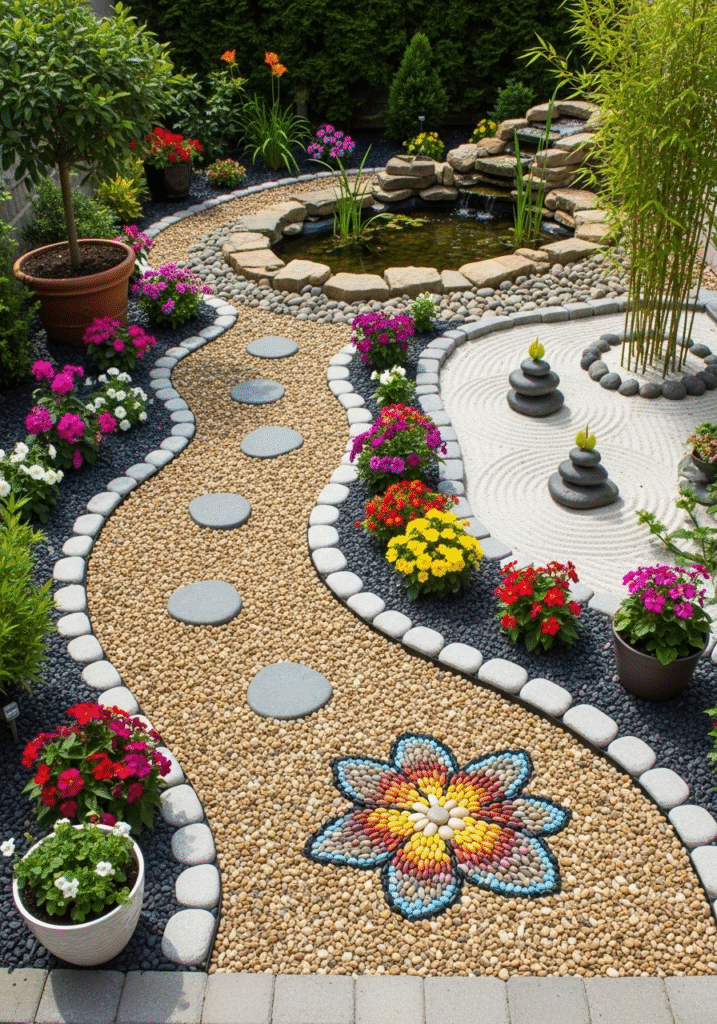
How to Lay Pebbles Properly (Step-by-Step Guide)
Installing pebbles in your garden may seem simple, but doing it the right way can make a big difference in how long they last, how neat they look, and how effective they are in controlling weeds or draining water. Whether you’re designing a pebble pathway, covering a flower bed, or enhancing a patio edge, a little preparation goes a long way.
Here is a step-by-step guide to help you lay pebbles properly in your garden, ensuring a long-lasting and professional finish.
Step 1: Clear the Area
Before you begin laying pebbles, start by clearing the area where you plan to install them. This means:
- Removing grass, weeds, and plants from the surface.
- Getting rid of rocks, roots, and debris that may cause unevenness.
- Digging out the top 2 to 4 inches of soil, depending on how thick you want the pebble layer to be.
This initial preparation is essential for creating a stable base and avoiding future maintenance issues. If you skip this step, weeds may grow back, or the pebbles could shift over time.
Step 2: Level and Compact the Ground
Once the area is cleared, it’s time to level the ground. Uneven surfaces can cause water pooling, pebble shifting, or make pathways uncomfortable to walk on.
- Use a shovel or landscaping rake to spread the soil evenly.
- After leveling, compact the surface to stabilize it. You can do this using:
- A garden roller
- A hand tamper
- Or simply by walking over the area firmly
Compacting the soil reduces settling and prevents pebbles from sinking too deeply over time.
Step 3: Lay Landscape Fabric
Laying down landscape fabric (also called weed barrier fabric) is a crucial step to ensure your pebble area remains clean and low maintenance.
- Roll the fabric over the entire area, allowing it to overlap slightly at the seams.
- Use landscape pins or U-shaped garden staples to secure it to the ground.
- Trim any excess fabric with scissors to fit the space perfectly.
This fabric prevents weed growth, keeps the pebbles from mixing with soil, and maintains a neat appearance for years.
Step 4: Add Edging (Optional but Recommended)
If you want your pebble area to have a clean, contained look, it’s a good idea to install edging around the perimeter. Edging serves multiple purposes:
- Keeps pebbles from spilling into lawns or flower beds
- Creates a defined border
- Enhances the overall visual appeal
You can use a variety of materials for edging, such as:
- Bricks or pavers
- Metal or plastic landscape edging
- Wooden beams or logs
- Concrete curbing
Install the edging securely before adding pebbles so it acts as a firm barrier.
Step 5: Pour and Spread the Pebbles
Now comes the fun part — laying the pebbles.
- Carefully pour the pebbles over the fabric, starting at one end and moving across the area.
- Aim for an even thickness of 2 to 3 inches for most garden areas.
- Use a metal garden rake to spread the pebbles evenly and ensure full coverage.
If you’re working in a small space like a planter or flower bed border, you can use a hand trowel to position the pebbles precisely.
You can also mix different colors or sizes of pebbles for a more artistic and layered design effect.
Step 6: Compact and Finish the Surface
Once the pebbles are evenly spread out, gently compact the surface to help them settle in place.
- Walk lightly across the area wearing flat-soled shoes.
- For larger installations, you can use a lawn roller to apply more even pressure.
- Lightly spray the surface with water using a garden hose — this helps settle dust and makes the pebbles look cleaner and more vibrant.
Inspect the entire area once finished. Fill in any thin spots and adjust the pebbles as needed.
Bonus Tips for a Better Finish
- For driveways or high-traffic paths, consider adding a gravel base layer below the fabric for added stability.
- To maintain a fresh look over time, add a thin new layer of pebbles every 1–2 years.
- For added effect, place solar lights or garden lanterns along pebble paths or edges.
Final Thoughts
Laying pebbles properly in your garden doesn’t require professional skills — just a bit of planning, patience, and precision. When done right, a pebble installation can last for years with minimal upkeep, offering both visual appeal and practical benefits like drainage, weed control, and improved soil stability.
By following this step-by-step guide, you’ll not only create a beautiful and well-structured garden feature but also enjoy a functional outdoor space that stays neat and inviting season after season.
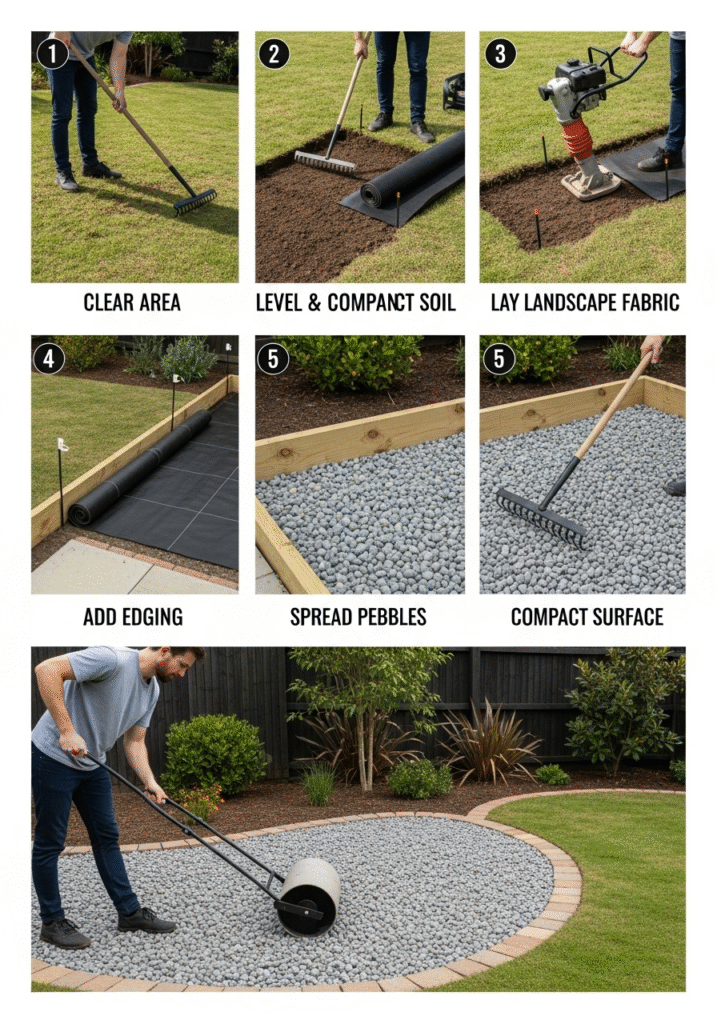
Tips for Maintaining Your Pebble Decorations
Pebble decorations are low-maintenance by nature, but like any part of your garden, they still require occasional care to keep them looking clean, fresh, and visually appealing. Over time, pebbles may shift, gather dust, or accumulate leaves and weeds. With a few simple maintenance habits, you can ensure your pebble-decorated areas stay tidy and attractive all year round.
Here are some practical and effective tips for maintaining your pebble decorations:
1. Regularly Remove Leaves and Debris
Fallen leaves, twigs, and garden debris can quickly collect on pebble-covered areas, especially in the autumn or after strong winds. If not removed, this organic matter can decompose and create a messy appearance or even encourage weed growth.
Use a leaf blower on a low setting or a soft-tined rake to gently sweep away the debris without disturbing the placement of the pebbles. A hand brush or broom works well for smaller spaces like planters or patio edges. Keeping the surface clean not only improves visual appeal but also extends the life of your landscape fabric underneath.
2. Wash the Pebbles Periodically
Over time, pebbles can become dusty, muddy, or discolored due to rain, pollution, or natural wear. Washing your pebbles once or twice a year helps restore their original color and texture.
To clean:
- Use a garden hose with a spray nozzle to rinse the surface gently.
- For deeper cleaning, scrub a section with a stiff broom or brush and water.
- Avoid using strong detergents or chemicals, especially near plants.
Washing your pebbles is especially important for lighter-colored stones like white marble or polished decorative pebbles, as dirt buildup is more noticeable on them.
3. Replenish Thin or Sunken Spots
Despite your best efforts, pebbles can shift or sink over time due to weather, foot traffic, or soil settling underneath. This may result in uneven surfaces, exposed landscape fabric, or patchy coverage.
To maintain an even and lush look:
- Inspect your pebble areas seasonally for thin or bare patches.
- Add a fresh layer of pebbles to these spots to even out the coverage.
- Rake the area gently to blend the new pebbles with the existing ones.
For frequently used walkways or patio borders, refreshing the pebble layer once every 1–2 years can help maintain a professional finish.
4. Keep Edging and Borders in Place
One of the most common issues with pebble landscapes is scattering — where stones slowly spread outside their intended space. This can make your garden look untidy and lead to extra cleanup work.
To prevent scattering:
- Make sure you have edging installed (like bricks, wood, plastic, or stone borders).
- Check borders periodically to ensure they’re still in place and not damaged.
- Reposition or reinforce edging as needed to maintain structure.
Sturdy, well-installed edging helps contain the pebbles, defines the shape of the area, and gives your design a clean, finished appearance.
5. Watch for Weed Growth and Treat Early
Although using landscape fabric underneath pebbles helps significantly reduce weed growth, some weeds can still sprout — especially along the edges or in areas with accumulated soil and debris.
To stay ahead of weed problems:
- Inspect your pebble-covered areas monthly, especially after rainfall.
- Pull any visible weeds out by hand, removing the roots to prevent regrowth.
- For minor infestations, apply a natural weed killer like vinegar spray (mix white vinegar with a small amount of dish soap).
- Avoid chemical herbicides near plant beds or water features to protect surrounding vegetation.
Keeping your pebbles weed-free ensures a clean and well-maintained look while preserving the functionality of your landscape.
Bonus Maintenance Tip: Add Decorative Lighting
While not a cleaning task, adding low-voltage garden lighting along your pebble pathways or beds can enhance their appearance — especially at night. Lights also help you spot debris or weed growth more easily during evening hours.
Final Thoughts
Maintaining pebble decorations in your garden doesn’t require much effort, but regular attention can make a huge difference. By keeping the area clean, replenishing when needed, and checking for early signs of weed growth or scattering, your pebble features will continue to look beautiful and serve their purpose for years to come.
With just a bit of seasonal upkeep, you’ll enjoy a tidy, polished, and peaceful garden landscape that always feels inviting — whether it’s a winding path, a flower bed border, or a Zen corner retreat.
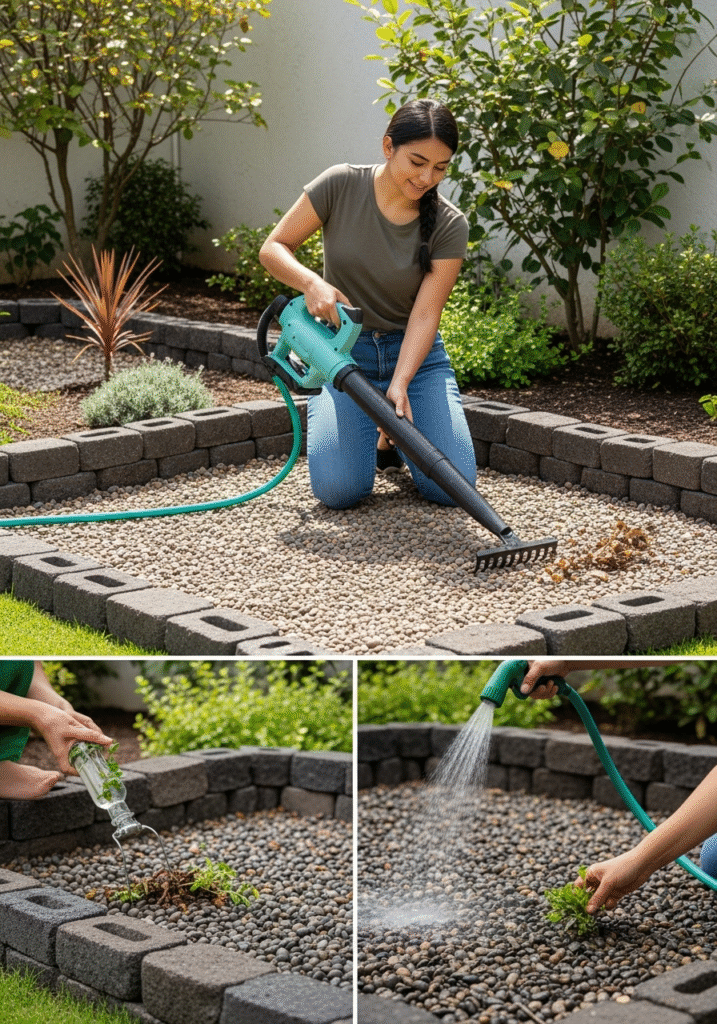
Cost-Effective Ideas for DIY Pebble Garden Decor
Decorating your garden with pebbles doesn’t have to be expensive. In fact, with a bit of creativity and resourcefulness, you can create stunning, personalized garden features using low-cost or even free materials. Whether you’re on a tight budget or simply enjoy hands-on DIY projects, there are plenty of ways to make your outdoor space beautiful and unique without spending a fortune.
Here are some budget-friendly, DIY pebble decor ideas that will help you save money while still achieving a charming and polished garden design.
1. Collect Local River Stones (If Permitted)
Purchasing decorative pebbles from a garden center or home improvement store can be costly — especially if you need large quantities. One of the best ways to save money is by collecting river stones or natural pebbles locally, as long as it is legal and environmentally responsible to do so in your area.
- Visit nearby riverbanks, dry creek beds, or rocky trails.
- Look for smooth, naturally rounded stones in varying sizes and colors.
- Be sure to check local regulations before collecting, as some areas may have restrictions or require permits to remove natural materials.
Once collected, wash the stones thoroughly to remove any dirt, moss, or algae before using them in your garden. These natural finds can be used for pathways, planters, or decorative edging.
2. Paint Old Pebbles for DIY Markers and Garden Art
If you already have pebbles in your garden or can get your hands on basic stones for free, you can transform them into colorful garden features using paint. Painting pebbles is a fun, creative, and affordable way to add personality to your garden.
Here are a few project ideas:
- Label herbs or vegetable patches with hand-painted name markers.
- Paint pebbles as ladybugs, bees, or butterflies for whimsical accents.
- Create inspirational message stones with words like “Grow,” “Peace,” or “Bloom.”
- Paint story rocks with shapes and patterns for kids to play with outdoors.
Use waterproof acrylic paints and seal them with a clear outdoor varnish to ensure they withstand the elements. This is a perfect weekend project for families, kids, or beginner crafters.
3. Create Mosaic Stepping Stones Using Broken Tiles and Pebbles
Instead of buying expensive pre-made stepping stones, you can make your own using recycled materials like broken ceramic tiles, old dishes, or glass pieces, combined with pebbles. This technique adds texture and color to your garden paths or seating areas while being environmentally friendly.
To make DIY mosaic stepping stones:
- Use a mold (like an old cake pan or shallow plastic tray).
- Pour in quick-setting concrete or mortar as the base.
- Press pebbles, tile pieces, or marbles into the surface in a desired pattern.
- Let it dry for 24–48 hours, then remove the mold.
You can personalize each stone with initials, shapes, or even handprints. These one-of-a-kind pieces will add artistic flair to your garden at a fraction of the cost of store-bought alternatives.
4. Upcycle Old Containers into Pebble-Filled Plant Stands
Got old buckets, crates, wooden boxes, or metal containers lying around? Don’t throw them away — turn them into rustic pebble-filled planters or stands for your garden!
Here’s how:
- Clean and repaint the container if needed.
- Fill the bottom with pebbles for drainage.
- Add soil and your favorite plants or succulents.
- Alternatively, fill the container entirely with pebbles and place potted plants on top for a raised display.
These upcycled pieces make great accent features in garden corners, patios, or balconies. You can even paint the crates or label them with chalkboard signs for a vintage garden theme. It’s sustainable, inexpensive, and adds tons of character to your garden.
Bonus Tip: Combine Pebbles with Other Natural Materials
Maximize your garden’s design on a budget by combining pebbles with twigs, driftwood, seashells, or recycled bricks. Natural and found materials pair beautifully with pebbles and help create layered, organic designs. This approach is ideal for:
- Mini rock gardens
- Terraced flower beds
- DIY fairy garden corners
- Decorative dry creek beds
With just a little imagination and effort, you can turn everyday items into stunning garden features.
Final Thoughts
You don’t need to spend a lot of money to create a garden that’s stylish, peaceful, and uniquely yours. By collecting natural materials, reusing old containers, and adding personal artistic touches with paint or mosaics, you can decorate with pebbles in a way that’s both affordable and impactful.
DIY pebble garden decor not only helps you stay on budget but also allows you to express your personality, reduce waste, and enjoy the satisfaction of crafting something beautiful with your own hands.
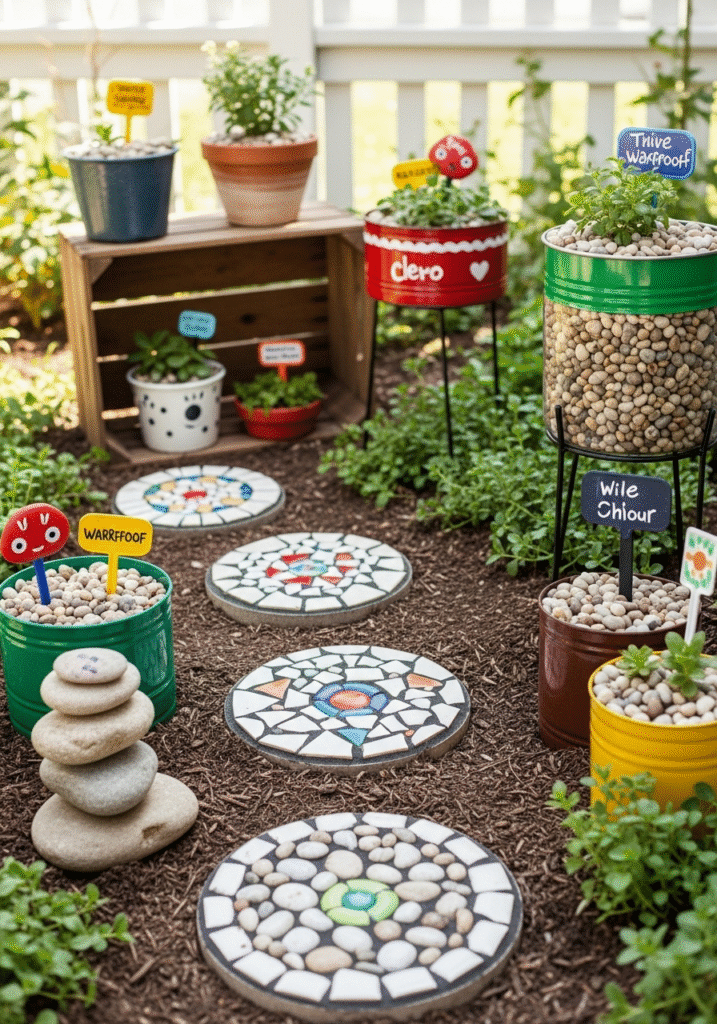
Environmental Benefits of Using Pebbles in the Garden
When we think of garden decoration, aesthetics often take center stage — but the choices we make in landscaping can also have a major impact on the environment. Pebbles, as a natural and reusable resource, offer several eco-friendly benefits that go beyond surface beauty. Incorporating pebbles into your garden design can support sustainable gardening practices, reduce waste, and help conserve water — all while keeping your space neat and stylish.
Here are the top environmental advantages of using pebbles in your garden:
1. Reduces Water Usage by Limiting Evaporation
One of the most pressing concerns in gardening — especially in hot and dry climates — is water conservation. Traditional mulching materials like bark or wood chips can dry out quickly and need frequent replacement. Pebbles, on the other hand, act as a long-term moisture barrier for the soil.
By creating a protective layer over the soil, pebbles help:
- Minimize direct sunlight exposure to the soil.
- Reduce water evaporation.
- Maintain consistent soil temperature and moisture.
This means your plants stay hydrated longer, reducing the need for frequent watering. Especially when combined with landscape fabric underneath, pebbles can help cut down water consumption by up to 50%, making them an excellent solution for eco-conscious gardeners.
2. Promotes Natural Drainage and Prevents Waterlogging
Proper drainage is crucial for maintaining plant health and preventing root rot. Unlike some materials that compact over time and trap moisture, pebbles allow water to flow freely through the soil.
Whether you use pebbles in flower beds, beneath trees, or around the base of potted plants, they help:
- Improve water infiltration and air circulation.
- Prevent standing water and soil erosion.
- Channel excess rainwater into the ground naturally.
This improved drainage supports healthier root systems, especially for drought-tolerant or native plants. It also helps prevent mold, mildew, and other issues that arise from waterlogged soil — all without needing artificial drainage systems or harsh chemical solutions.
3. Reduces the Need for Chemicals and Mulching Materials
In most gardens, organic mulch needs to be replaced every few months or at least once a year, depending on the climate and weather conditions. Mulch also tends to break down over time, attracting pests and encouraging fungal growth if not monitored closely.
Pebbles, in contrast:
- Don’t decompose, so they last for years without needing to be replaced.
- Provide a natural barrier against weeds, reducing the need for herbicides.
- Discourage pest infestations compared to moist organic mulch.
- Don’t require chemical treatments or synthetic fertilizers to stay effective.
This translates into a reduced environmental footprint, as you’ll be using fewer disposable materials and minimizing the use of harmful chemicals in your garden. It’s a smart, eco-friendly alternative that saves both money and resources in the long run.
4. Long-Lasting and Reusable Material
Unlike bark mulch, compost, or synthetic ground covers, pebbles do not degrade over time. Once installed, they can remain effective and attractive for decades with minimal upkeep. Even if you decide to change your garden layout later, you can easily:
- Remove and relocate the pebbles to a new area.
- Rinse and reuse them in planters, pathways, or borders.
- Repurpose them for DIY garden art or other landscaping projects.
This reusability makes pebbles a truly sustainable resource, contributing far less to landfill waste than single-use gardening materials. Their long life span reduces demand for replacement products and minimizes your garden’s environmental impact over time.
Bonus Benefit: Supports Natural Habitats
Pebbles can also be used in environmentally sensitive designs that support local ecosystems. For example:
- Creating dry creek beds and rain gardens that manage stormwater runoff.
- Building pollinator-friendly areas with low-maintenance pebble beds and native plants.
- Designing habitat zones for beneficial insects, lizards, and birds by integrating pebbles with natural materials like wood, logs, and wildflowers.
These applications promote biodiversity while also conserving water and reducing artificial landscape inputs.
Final Thoughts
Decorating your garden with pebbles is not just a style choice — it’s an investment in sustainability. From reducing water use and chemical dependency to promoting soil health and preventing waste, pebbles are a smart and environmentally responsible addition to any garden.
By choosing pebbles over disposable or synthetic materials, you contribute to a healthier planet while still creating a beautiful, low-maintenance outdoor space. Whether you’re a seasoned eco-gardener or just beginning your green journey, pebbles provide a simple, effective, and elegant way to go greener in your garden.
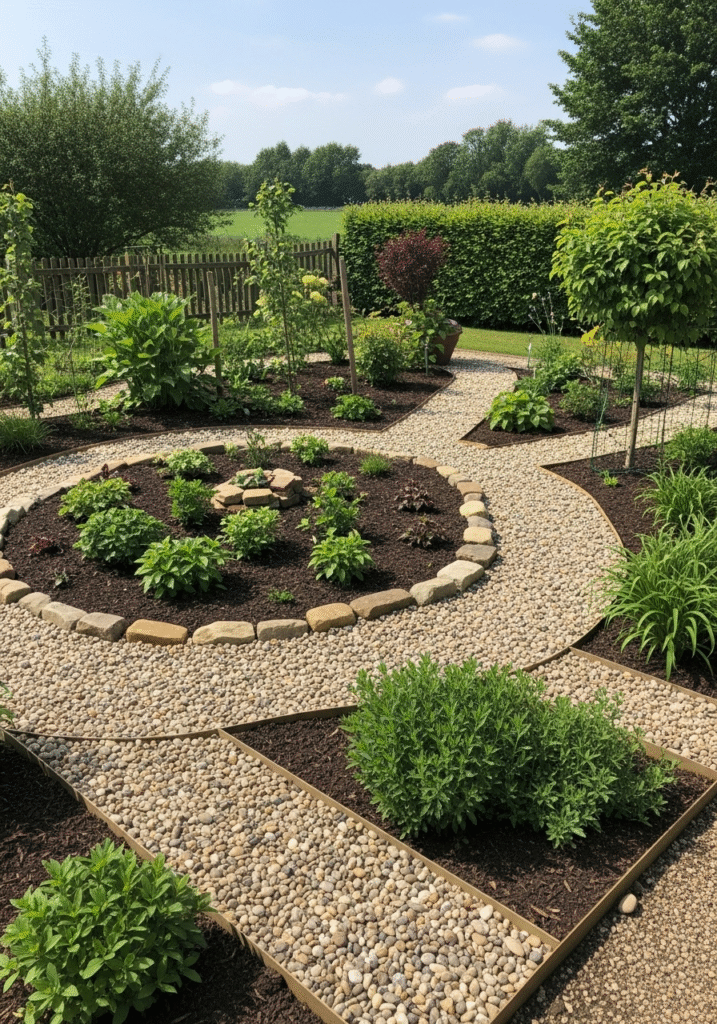
Conclusion
Decorating your garden with pebbles is more than just a trend — it’s a timeless and practical landscaping technique that enhances beauty, improves functionality, and supports environmental sustainability. Whether you’re designing a modern outdoor oasis or a rustic natural retreat, pebbles provide a cost-effective and long-lasting solution for gardeners of all skill levels.
From peaceful Zen corners and artistic mosaic features to neat walkways and low-maintenance flower beds, the possibilities for pebble decoration are nearly endless. These small stones may seem simple, but they have the power to completely transform your garden by adding texture, color, and structure. With just a bit of planning and creativity, you can achieve professional-looking results without breaking your budget.
Why Pebbles Are the Perfect Garden Addition
What makes pebbles such a popular choice for outdoor decor is their unique blend of beauty and practicality. Here’s why homeowners and landscape designers around the world continue to use them:
- Durability: Unlike organic mulch or wood chips that decompose over time, pebbles can last for many years without needing replacement.
- Versatility: Pebbles can be used in a wide range of garden features — from large pathways to small potted plants — and suit nearly every garden style.
- Low Maintenance: Once laid properly, pebbles require minimal upkeep. Occasional raking or rinsing is often enough to keep them looking fresh and clean.
- Eco-Friendly: By improving soil drainage, reducing water evaporation, and limiting the need for chemical herbicides, pebbles support a healthier, more sustainable garden environment.
- Aesthetic Appeal: With a variety of colors, shapes, and sizes to choose from, pebbles offer endless opportunities to create visually striking landscapes that reflect your personality.
Simple, Affordable, and DIY-Friendly
One of the greatest advantages of pebble decor is that it’s incredibly DIY-friendly. You don’t need to hire a professional landscaper to create a beautiful garden feature. Whether you’re laying a small pathway, adding a pebble layer to a planter, or making a mosaic stepping stone, the process is simple and enjoyable.
Many of the ideas shared in this guide — such as using painted pebbles as garden markers or upcycling old containers into pebble-filled plant stands — can be done using basic tools and low-cost materials. And if you’re looking to save even more, consider collecting local river stones (where allowed) or repurposing materials you already have at home.
Ready to Get Started?
With all the tips, techniques, and creative ideas discussed in this blog, you’re now fully equipped to begin your pebble garden transformation. Whether you want to:
- Create a charming garden path
- Build a peaceful Zen meditation corner
- Highlight your flower beds with neat pebble borders
- Or simply enhance your planters with decorative stone
You now have all the knowledge you need to execute your vision confidently.
Remember to plan your layout, choose the right type of pebble for your project, and prepare the area properly before installation. A little effort during setup will go a long way in ensuring a long-lasting, low-maintenance result.
Final Thoughts
Garden decoration with pebbles offers a perfect blend of simplicity, affordability, and elegance. It’s a wonderful way to refresh your outdoor space, increase curb appeal, and bring a calming natural vibe to your home — all while being environmentally friendly and easy to maintain.
So don’t wait for a full garden overhaul or expensive renovation. With just a few bags of pebbles and a spark of creativity, you can breathe new life into your garden — one stone at a time.
Let nature inspire you, and let pebbles be your tool for creating an outdoor sanctuary that’s both beautiful and sustainable.
